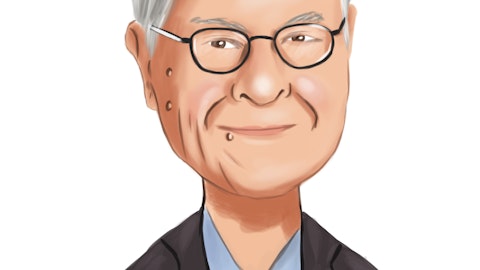Ram Selvaraju: Hi guys. So if you could just sort of give us a bit more granularity on the changes in customer acquisition strategy that you’re looking to make and which ones do you expect to be the most impactful and why? And then the follow up I have is specifically with respect to the decision making process around choosing a pharmaceutical development path versus a supplement or a food path; and if we should expect such a selection process to conclude over the course of 2023. So if indeed you’re going to potentially go after an Rx product development approach, with anything you perhaps even with one of these newer analogs. If you’re going to reach conclusion of that decision making process and disclosure of the target indication in question before the end of 2022? Thanks.
Rob Fried: So I’m going to answer in order that you asked. First of all, I’ll answer the customer acquisition question and then I’ll answer the pharmaceutical question. The way we approach customer acquisition is largely based on the science. So as studies come out, we begin to understand better and better how nicotinamide, riboside impacts consumers. Initially it was all preclinical studies. Now you’re seeing a whole state of clinical studies and we understand fairly well now that it has a very serious and positive impact on a whole host of indications and structure function. You see liver, you see brain, you see cellular energy there’s quite a few; they all ladder up to aging if you will. We break that down into individual cohort groups and then we target those cohort groups through customer acquisitions.
So you create creative materials that attack €“ that appeal to cohort groups that are interested in for example, cognition. And then you create a series of ads that appeal to them and you target them and then you create a click path process for optimizing that sale, and we do it fairly well on several platforms and we used to do it better. On our fundamental website, and we will in the coming weeks get back to that again. But over the last year or so, we’ve adopted a strategy that is not optimized and so that is our process. Once you do that process, it’s then just a sense of consistent measurement. Which ones are converting? Do we have to make minor changes to optimize them? Are any of them falling off? If so, do they? And the ones that are converting with a reasonable return on ad spend that’s paying off, then you hit the gas pedal hard and you spend more in those cohort groups.
And those are the basic fundamental economics of running an e-commerce business. And we’ve done it fairly well, but we’ve done it less well of late. So it’s an opportunity for us to improve it. And my expectation is maybe not in the first quarter, but shortly thereafter we’re going to start seeing real growth. We did not bake that growth into our projections, however. It’s another reason why we are conservative with our projections, at least on the website. That’s the acquisition strategy. The retention strategy, once you have them as a customer or as a subscriber, has to do with two things. One is regular communications, and the other is we find that people that take a sufficient amount of Tru Niagen that’s generally more than 100 milligrams, 300-plus and who take it for more than a couple of months rarely cancel.
Because if they pay attention to the way the body is performing, they realize it’s a meaningful difference. We also notice that people who take it for a period of time and stop notice the difference once they stop and then come back as customers. So Tru Niagen has a very, very strong retention rate for those that take it for a couple of months and take sufficient dosage. And those are the two component pieces, acquisition and retention, and that’s how we approach it. We have found that aging works as a cohort group. Cellular energy works as a grow cohort group and a growing cohort group for us is cognition. So if you have no follow up questions, okay, great. So let me jump to the second question, which is pharmaceutical. So you in particular have been very helpful for us in thinking that our pharmaceutical strategy, because you consistently ask good and smart questions about that.
Obviously you know a lot about the space. When we release a product in the pharmaceutical space, and we don’t think it’s an, if we think it’s when, we think it is part of our strategy at the company. It’s important that it not be identical to the product that we’re selling as a dietary supplement, not just in dose, but also in composition and molecular structure. So this is why some of the other analogs that we have are so valuable and why you and others know this company is really two companies. It is a consumer company, but it is also a fairly significant R&D company for which the investment community has not yet embraced. But there is some ample R&D going on here for some very important indications as you’ve seen in the studies. It’s not just Parkinson’s, it’s not just Alzheimer’s there’s many others.
Neurological, mitochondrial, inflammation is also a disease, there’s quite a few put and there is all these orphan diseases like Cockayne syndrome, which represent opportunities for us. But that process takes a while and we’ve done quite good work in preclinical and Phase 1 and now in many cases Phase 2 studies, which one we will propose, which pursue. Now of course the company’s not really fully financed or structured as a straight biotech R&D company, so the likelihood is that we will be working with a partner and we do have frequent meetings with many biotech and pharmaceutical companies about this topic. And a lot has to do with what their interest is. I do expect us to do something in 2023 in the space structurally in terms of pursuing pharmaceutical strategy.
It is likely to be one of the other analogs.
Ram Selvaraju: Thank you very much.
Andrew Shao: Thank you.
Operator: Our next question comes from Jeff Cohen from Ladenburg Thalmann. Please go ahead. Your line is open.
Destiny Hance: Hey, thank you. This is actually Destiny on for Jeff. I hope everyone is doing well. Most of my questions have actually been answered, which is great. I am curious to know a bit more about this branding initiative or event that you mentioned. Could you give us a few more details on that please?
Rob Fried: Hi, Destiny. If you recall a year ago we endeavored to pursue a television campaign for about six weeks. And we created a television spot, which we tested and launched and it actually did quite well. The reason why we pulled back from that campaign is, it’s a number of reasons. One of which is we all know what’s happened in the economy in the last year and what’s happened in the capital markets and the importance of being cash flow positive and focusing on the bottom line as well as the top line. And it was doing well, but not well enough to pay for itself. So we €“ it’s not that we are not going to pursue that strategy. We decided to pull back from what is a very expensive and aggressive strategy, mass retail plus television at the right time we will get back into it, but it’s not now.
But we understand that what we’re sitting on with Tru Niagen at 20% growth annually, 10%, 20%, 30% growth is pretty good, but not good enough. A company that’s doing $20 million a year with a product like this should be doing $200 million a year €“ a quarter. It’s too good a product. It has too good an impact on people’s health. So we do need to take some shots and yes, we’re conservative, but we need to take our shots carefully and we are going to take another shot in the coming weeks and if that works, we’re going to hit the gas pedal again on that. And we have other shots that we’re planning later on in the year. We recognize the upside potential. We just want to do it smartly and carefully. There’s not much more that we can tell you about that specific opportunity right now.
The reason for that is, look, we’ve learned a lot about this dietary supplement business and those of you that have been with us for the last few years have also seen there are a lot of different players out there, very few of whom actually do science or research, but a lot of whom like to steal other people’s research or steal credit for it or infringe on patents. There are a lot of strategies out there and we find that we are imitated quite a bit and when we try something, we find that quickly thereafter, a lot of people are following us either in message or in platform or in channel in some cases very aggressively. So we think it’s important that we be in stealth mode until the campaign launches in the coming weeks, and that’s the only reason.
But you’ll see it and we have high hopes for it, but we’re not counting on it. We have nothing in the projections for it. We have very conservative projections for it, but we’ll see. We think it has a good risk reward profile. I can’t really tell you much more than that right now.




